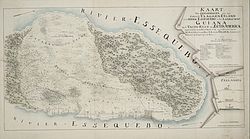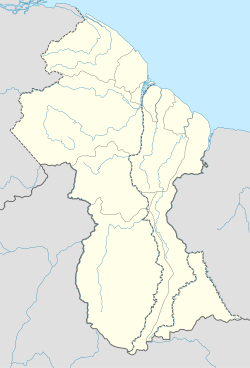Fort Zeelandia (Guyana)
| Fort Zeelandia | |
|---|---|
| Part of Essequibo | |

Map of Fort Zeelandia on the Flag Island
|
|
| Coordinates | 6°47′00″N 58°31′00″W / 6.783333°N 58.516667°W |
| Site history | |
| Built | 1726 |
| Garrison information | |
| Occupants | Netherlands (1726-1815) |
Fort Zeelandia is located on Fort Island, a fluvial island of the Essequibo River delta in the Essequibo Islands-West Demerara region of Guyana. Not to be confused with Fort Zeelandia in Paramaribo, Suriname, the current brick fort was built in 1743 for the Essequibo colony, replacing an earlier wooden fort built in 1726, and is among the oldest structures in Guyana. The fort replaced Fort Kyk-Over-Al as the capital of Essequibo in 1739.
The small fort is a 15 x 20 m structure surrounded by four ramparts at each corner. Constructed during the Dutch possession of the region, the fort was a vital defensive fortification strategically located at the mouth of the Essequibo River.
From the beginning of the 18th century, the commanders of Essequibo recommended that the location of the colony's administrative centre be removed as a result of the relocation of the Dutch settlers on the fertile banks of the Essequibo River.
In 1726, it was resolved that a fort should be constructed to protect the planters and the interest of the Dutch West India Company (DWIC). In 1726, Leslorant, an engineer was sent from the Netherlands to construct a horn work with wooden redoubt and a strong palisade of the northern point of Vlaggeneiland (Flag Island). In August 1738, Laurens Storms van Gravesande, the Secretary to Commander Gleskerk, inspected the fort and reported that the structure was falling to pieces. He recommended to the Directors of the Netherlands that a new fort of brick be built to defend the interest of the DWIC.
Construction of the fort commenced in 1740 and with the labour of enslaved Africans the structure was completed in 1743. Brick was baked on the spot and mortar and trass were imported from Barbados and the Netherlands. The entire complex was however completed in 1749 as construction was delayed as a result of the shortage of building materials and labour. The completed structure was then christened Fort Zeelandia after the County of Zeeland in the Netherlands, from which many of the original settlers had originated.
...
Wikipedia

